 by "ttyymmnn" (ttyymmnn)
by "ttyymmnn" (ttyymmnn)
Published 10/17/2017 at 12:35
 by "ttyymmnn" (ttyymmnn)
by "ttyymmnn" (ttyymmnn)
Published 10/17/2017 at 12:35
Tags: planelopnik history
; Planelopnik
STARS: 8
!!! UNKNOWN CONTENT TYPE !!!
Welcome to
This Date in Aviation History
, getting of you caught up on milestones, important historical events and people in aviation from October 14 through October 17.
!!! UNKNOWN CONTENT TYPE !!!
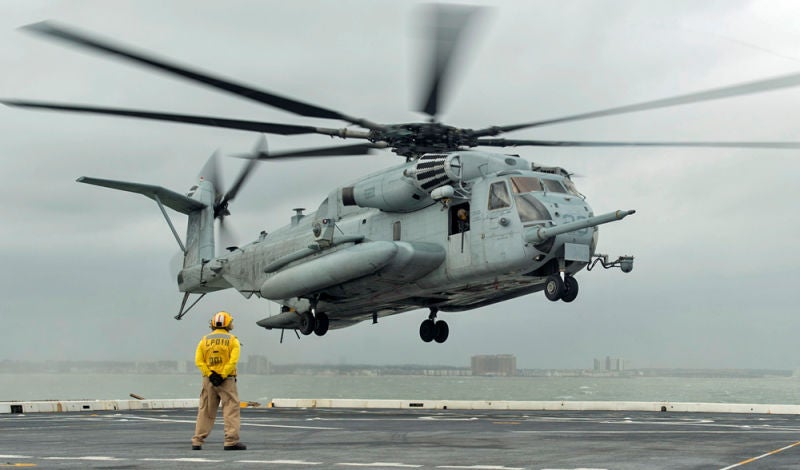
October 14, 1964 – The first flight of the Sikorsky CH-53 Sea Stallion. The jet engine not only revolutionized fixed wing aviation, but it also had a profound effect on the development of helicopters, as the turbine engine offered greater power and speed over its piston-powered predecessors. In 1960, both the US Army and US Marine Corps began searching for a heavy lift helicopter to replace the CH-37 Mojave/HR2S , and the Army eventually settled on the tandem-rotor Boeing CH-47 Chinook . In 1962, the US Navy issued a request for a Heavy Helicopter Experimental (HHX), calling for a helicopter that could lift up to 8,000 pounds, have an operational radius of 100 nautical miles and a speed of 170 mph. In order to save money, Defense Secretary Robert McNamara , who had built a reputation for trying to save money by getting different branches of the military to adopt the same aircraft, pressured the Marine Corps to adopt the Chinook. But the Marines argued that their requirements were significantly different from those of the Army. In particular, they expressed the need for a watertight hull, and they preferred to accept the offering from Sikorsky, which was basically an enlarged version of the S-61R . After an intense competition, the Marines selected the YCH-53 over the Chinook, announcing in 1962 that it would procure two prototypes for further testing. (The US Air Force later adopted the CH-53 as the HH-53 Super Jolly Green Giant for combat search and rescue). The CH-53 had a six-bladed main rotor that was borrowed from the S-64 Skycrane (CH-54 Tarhe), a watertight hull (not intended for amphibious operations, the hull only allows emergency landings on water), and was powered by a pair of General Electric T64 turboshaft engines mounted on pods outside the aircraft. Successively more powerful engines were added as development of the helicopter continued. The Sea Stallion had a crew of four and, depending on the mission could carry 38 troops, or 24 stretchers with attendants, or an internal cargo payload of 8,000 pounds. An external load of 13,000 pounds could be slung underneath the aircraft. The CH-53 saw immediate action in the Vietnam War, where it played a vital role in troop and materiel transport and search and rescue. At the end of America’s involvement in the war, the size of the Sea Stallion aided tremendously in the evacuation of troops and civilians from Saigon as part of Operation Frequent Wind . The Sea Stallion proved its mettle in every conflict since Vietnam, but was finally retired in 2012 after service in Afghanistan in favor of the CH-53E Super Stallion , a significantly upgraded and modernized version of the heavy lifter that benefits from the addition of a third turboshaft engine. (US Navy photo)
!!! UNKNOWN CONTENT TYPE !!!
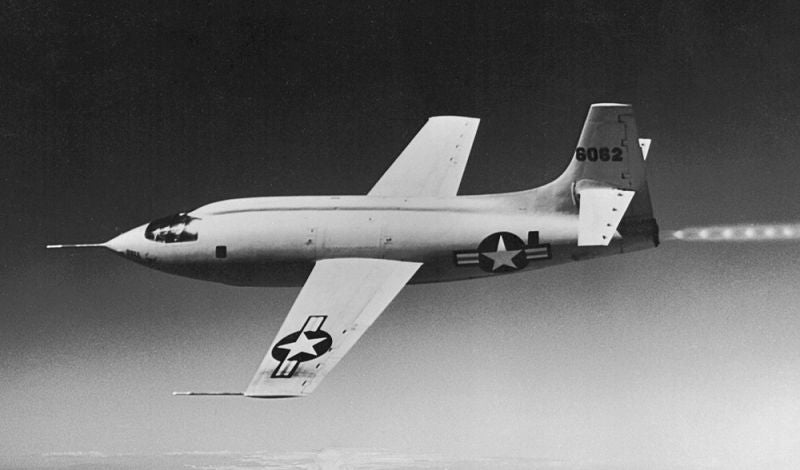
October 14, 1947 – Chuck Yeager breaks the sound barrier in the Bell X-1. On December 17, 1903, the Wright Brothers made their historic First Flight. Taking off from the dunes of Kitty Hawk, NC, the Wright Flyer covered a distance 120 feet at a speed of 6.8 mph and, since that momentous date, aircraft development has been driven largely by a quest for ever greater speed. But when the world entered the age of jet- and rocket-powered flight during WWII, the last great landmark of speed was the speed of sound, or Mach 1, about 765 mph depending on altitude and conditions. But flying faster than the speed of sound was entirely uncharted territory. During the war, rocket planes and airplanes in a steep dive had come close, entering the realm of transonic flight, where they discovered that shockwaves that formed on the aircraft severely inhibited the ability of the control surfaces to move, or could even cause control inputs to reverse. Some German pilots laid claim to breaking the sound barrier in the Messerschmitt Me 163 Komet rocket plane, but it was the British who made the first dedicated attempts at supersonic flight with the turbojet-powered Miles M.52 . An extremely advanced aircraft for its time, the M.52 attempted to solve the controllability problems by pioneering the use of a powered stabilator , or flying tail, in which the entire horizontal tailplane moved, rather than just the elevators on the trailing edge of the tail of the horizontal stabilizer. Though the project was ultimately canceled, much of the Britain’s groundbreaking work in supersonic aerodynamics found its way to Bell as part of an agreement to share technical data on high-speed flight. Bell had already begun work on a supersonic rocket plane, but they had been employing a conventional tail suffered from the problems of compressibility at transonic speeds. With the data from the M.52 in their hands, Bell adopted the all-moving powered stabilator and the problem was solved. Where the M.52 was powered by a turbojet, the X-1 was powered by a four-chamber Reaction Motors liquid fuel rocket, with each chamber providing 1,500 lbf of thrust, and the chambers could be added one at a time to accelerate the aircraft. The X-1's maiden flight, a gliding test in Florida, took place on January 25, 1946. After a successful series of glide tests, the X-1 was taken to Muroc Army Air Field in California, modern day Edwards Air Force Base , for powered tests. Bell chief test pilot Jack Woolams , who flew all the glide tests, had died on August 30, 1946 while practicing for the National Air Races in Cleveland, and another Bell test pilot, Chalmers “Slick” Goodlin , demanded $150,000, the equivalent of about $1.6 million today, to make the flight. So the task fell to Chuck Yeager.
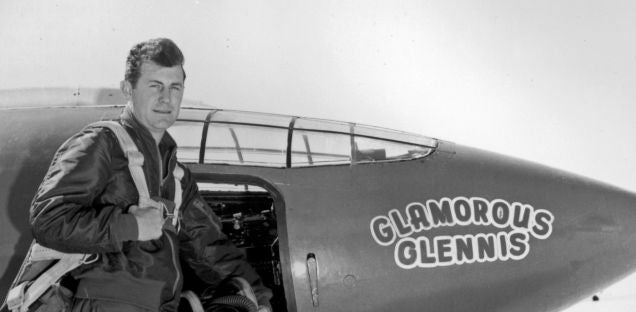
Yeager began his military career as an enlisted aircraft mechanic before training as a pilot, and he became an ace while flying the North American P-51 Mustang in WWII. Two days before the historic flight, Yeager broke two ribs in a horse riding accident, but he hid the injury from the Air Force so he wouldn’t be barred from flying. The pain from the injury made it impossible for him to close the hatch on the X-1, so fellow pilot Jack Ridley rigged a broom handle to the door to allow Yeager to close it. Yeager nicknamed the bright orange X-1 Glamorous Glennis after his wife, the same name he had given his Mustang. On October 14, 1947, Yeager and the X-1 were taken aloft by a modified Boeing B-29 Superfortress and dropped over the dry lake bed. Yeager fired the rocket engine after falling clear of the B-29 and accelerated the X-1 to a speed of Mach 1.07 at 45,000 feet, thus becoming the first plane and pilot to break the speed of sound in level flight. After the rocket fuel was expended, the X-1 glided to a soft landing on Muroc’s the lake bed. For his historic flight, Yeager was awarded both the Mackay and Collier Trophies in 1948, and he received the Harmon International Trophy in 1954. The Glamorous Glennis now resides at the National Air and Space Museum in Washington DC. After the historic flight, Yeager continued to set more speed records, and held various Air Force commands before retiring at the rank of brigadier general. Not only was the data gleaned from the X-1 flights used in future X planes and supersonic aircraft, the entire test and evaluation program served as a model for all future X plane projects. This has led to aircraft such as the Lockheed SR-71 Blackbird which routinely flew at three times the speed of sound, to the experimental NASA X-43 hypersonic aircraft, which has reached speeds approaching Mach 10. It is also worth noting that Orville Wright was still alive when Yeager broke the sound barrier, though he died two months later. In a testament to the rapid technological advances of the airplane in the quest for speed, the world had gone from the first flight to Mach 1 in the span of one man’s life. (US Air Force photos)
!!! UNKNOWN CONTENT TYPE !!!
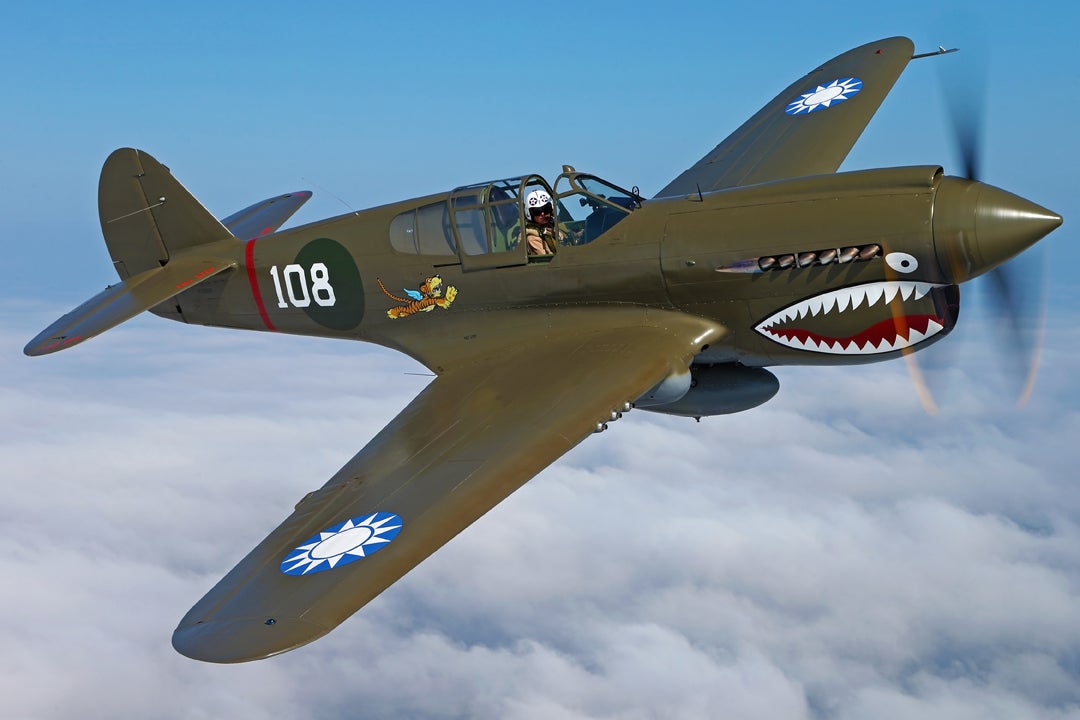
October 14, 1938 – The first flight of the Curtiss P-40 Warhawk. The Curtiss P-40 Warhawk has become one of the iconic aircraft of WWII, perhaps best known for its service with the 1st American Volunteer Group fighting in China. Fighting to defend the Chinese Nationalist government from Japanese invasion, the Flying Tigers, in their classic shark-mouthed P-4os, fought admirably against more maneuverable Japanese aircraft. While the P-40 was neither the fastest nor the most nimble fighter of the war, it was one of the most numerous, and was available to America and her allies in numbers before more powerful fighters could be brought to bear. The Warhawk traces its roots back to the Curtiss P-36 Hawk , a fighter that was designed at the same time as the Messerschmitt Bf 109 and Hawker Hurricane . It proved popular with pilots and, though it saw limited action at the outbreak of WWII, the P-36 fought well for the French in the early years of the war. But while the P-36 was liked for its good handling, it suffered from a serious lack of power. The P-40 was developed from the tenth P-36A Hawk airframe and, rather than using the Pratt & Whitney R-1830 Twin Wasp radial of the P-36, the Warhawk was fitted with an Allison V-1710 V-12 engine, the same engine found in the Lockheed P-38 Lightning and the Bell P-39 Airacobra and the only operational American-designed V-12 liquid-cooled engine developed by the US during the war. Interestingly, the original P-40 design called for the radiator to be placed behind the pilot, but the Curtiss-Wright sales department asked that it be moved to the front, perhaps in an attempt to make the P-40 look more like its P-36 predecessor in hopes of making it more appealing to the Army. The radiator placement gave the P-40 its iconic shark mouth silhouette, and the rear-mounted radiator later became the trademark of another famous fighter, the North American P-51 Mustang . A major drawback for the new fighter, however, was its single-stage, single-speed supercharger. But what the Warhawk gave up in performance it made up for in ruggedness and firepower. The lack of power limited the Warhawk’s performance against more powerful German aircraft at high altitudes, but it more than held its own under 16,000 feet. And while more nimble aircraft, such as the Japanese Mitsubishi A6M Zero , could outmaneuver the Warhawk, the development of effective tactics gave it an edge against the fragile Japanese designs.
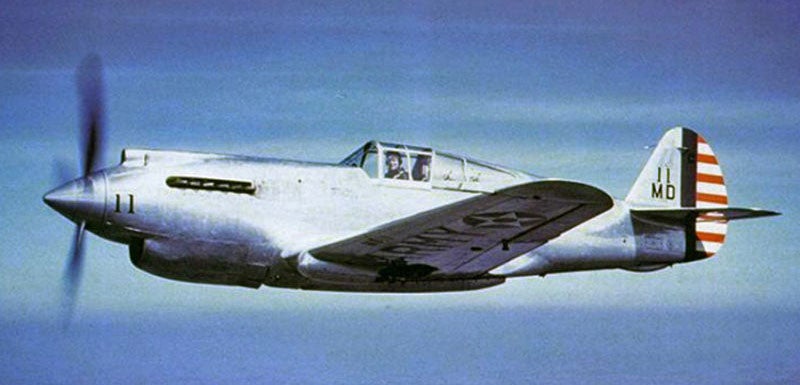
The P-40 was developed into a myriad of variants, including the P-40F and P-40L, both of which mounted a Packard V-1650 Merlin V-12 in place of the Allison. But with the majority of the Merlin engines going to the P-51, Curtiss reverted to the Allison engine, and it was the P-40N that became the definitive model and was produced in the greatest numbers, with 5,220 of the nearly 14,000 fighters built as the P-40N. The N retained the stretched fuselage that was introduced with the F, and attempts were made to further lighten the aircraft by removing two of the six wing-mounted .50 caliber machine guns. But in practice, the added firepower was preferable to the increase in speed and the guns were replaced. The metal fuselage behind the pilot was opened up and covered with plexiglass to improve rearward visibility, and the rugged, powerful fighter was used primarily for ground attack from 1944 onward. The P-40 was the third most-produced American WWII fighter behind Republic P-47 Thunderbolt (15,660) and the P-51 Mustang (15,586). It was also exported to almost every Allied combatant in WWII, and found great success with the Royal Air Force and Royal Australian Air Force, where it was known as the Tomahawk and later the Kittyhawk. (Photo author unknown via Military Aviation Museum ; XP-40 in flight via US Air Force)
!!! UNKNOWN CONTENT TYPE !!!
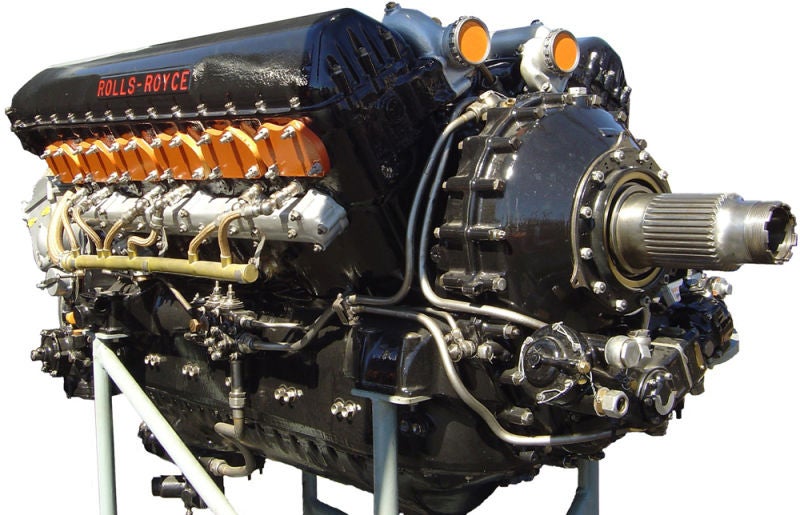
October 15, 1933 – The Rolls-Royce Merlin engine is started for the first time. Hurricane. Spitfire. Lancaster. Mosquito. Mustang. These are the names of some of the greatest aircraft to come out of WWII, and they all share one thing in common: the mighty Rolls-Royce Merlin 12-cylinder engine, one of the most successful aircraft piston engines ever produced. Work began on the the Merlin in the early 1930s when Rolls-Royce determined that they needed an engine that could provide more power than the 21-liter Kestrel engine then in production. The Kestrel had provided power for a great number of British and even German aircraft, though most of those types were obsolete by the outbreak of WWII. The new 1,100 hp engine was called the PV-12, as it was a private venture that received no government funding for its development. At first, Rolls-Royce chose an evaporative cooling system for the PV-12 engine, but that arrangement was abandoned in favor of a more traditional liquid cooling system when the former proved to be unreliable and ethylene glycol , which helps with the liquid cooling process, became available from the US. As the new engine was under development, the Air Ministry issued requirements for two new fighters, and both the Hawker Hurricane and Supekrmarine Spitfire were be built around the new PV-12 engine, rather than the Kestrel.
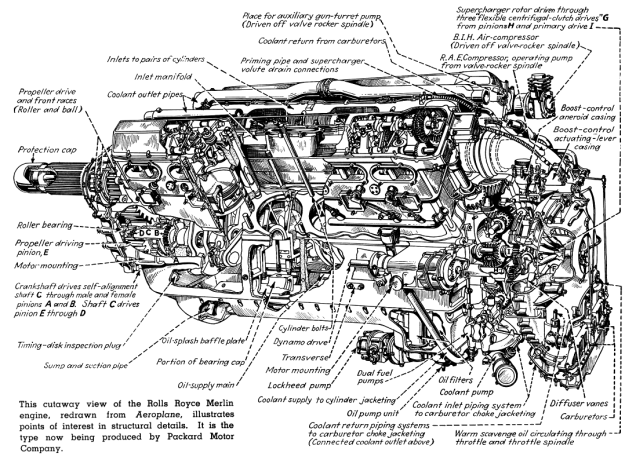
In keeping with the tradition of naming their engines after birds of prey, the PV-12 was renamed for the
Merlin
, a small falcon known for its speed and agility. The Merlin was first mated to a
Hawker Hart
biplane for testing, but the first run of production engines was fraught with unreliability, such as cylinder head cracking, coolant leaks, and excessive wear to the camshafts and crankshaft main bearings. These problems were ironed out in the development process, and the Merlin II and Merlin III became the standard production engines. Development of a
centrifugal supercharger
progressed alongside engine development, and
water injection
further improved the engine’s high altitude performance. The Merlin was produced in England as well as under license by
Packard
in the US as the
V-1650 Merlin
, and would eventually be used to power 43 different aircraft, from single-engine fighters like the Spitfire and
North American P-51 Mustang
to large four-engine bombers such as the
Avro Lancaster
. Nearly 150,000 were built by the time production ended in 1950.
(Photo by JAW via
Wikimedia Commons
; cutaway author unknown)
!!! UNKNOWN CONTENT TYPE !!!
!!! UNKNOWN CONTENT TYPE !!!
!!! UNKNOWN CONTENT TYPE !!!

October 14, 2012 – Felix Baumgartner sets a new altitude record for a parachute jump. The jump was part of the Red Bull Stratos project which set out to break the existing parachute altitude record of 102,8oo ft set by US Air Force Capt. Joseph Kittinger during the Excelsior project in 1960. Stepping out of a capsule suspended from a balloon, Baumgartner dove from an altitude of 128,097 feet and reached a speed of 1,357.64 mph in free fall, becoming the first person to break the speed of sound without a vehicle. Baumgartner’s record stood for just two years before it was broken by Google executive Alan Eustace , who jumped from 135,890 feet. (Photo via Felix Baumgartner Facebook )
!!! UNKNOWN CONTENT TYPE !!!
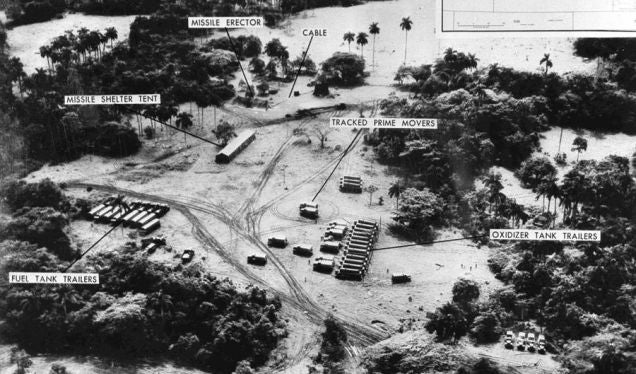
October 14, 1962 – A US Air Force Lockheed U-2 reconnaissance flight over Cuba discovers Russian-built ballistic missile launching facilities, triggering the Cuban Missile Crisis . Following the failed Bay of Pigs Invasion in 1961 and the installation of American missiles in Italy and Turkey, Cuba requested that the Soviets place missiles in Cuba to deter any more American action against the Cuban Revolutionary government. The US demanded that the R-14 Chusovaya medium-range nuclear missiles be removed and, after a tense 13-day stand off highlighted by low-level US reconnaissance flights over Cuba and an American naval blockade of the island nation that put the world on the brink of nuclear war, the Russians backed down and agreed to dismantle the sites and remove the missiles. (Department of Defense photo)
!!! UNKNOWN CONTENT TYPE !!!
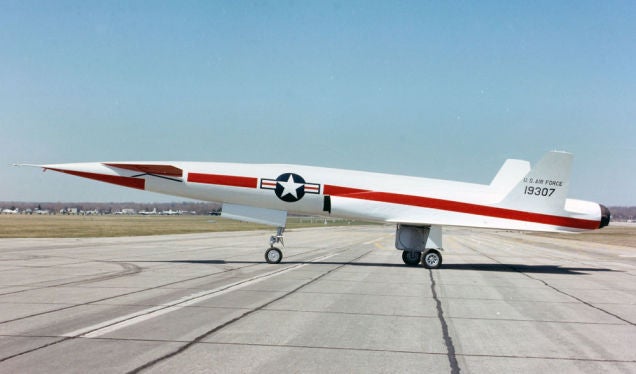
October 14, 1953 – The first flight of the North American X-10, an unmanned aircraft powered by two Westinghouse J40 turbojets and designed to investigate the feasibility of long-range cruise missiles. Though essentially a flying missile, the X-10 was fitted with landing gear which made the aircraft reusable. It had a delta wing and forward canard , and was controlled in flight by an onboard computer. When the X-10 entered service for testing, it was the fastest turbojet-powered aircraft of its day, with a maximum speed of Mach 2 and could reach an altitude of 49,000 feet with a range of 627 miles. Thirteen research aircraft were built, though only one survives, and it is housed at the National Museum of the United States Air Force in Ohio. (US Air Force photo)
!!! UNKNOWN CONTENT TYPE !!!
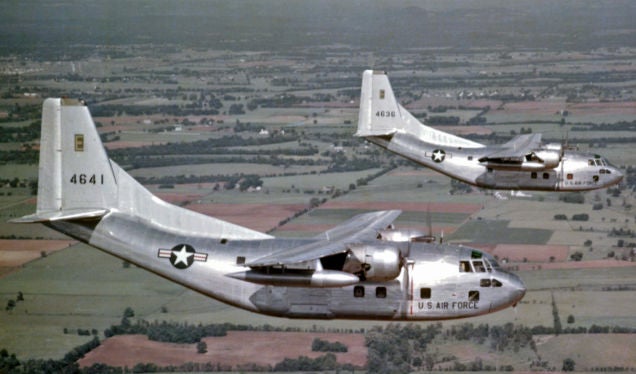
October 14, 1949 – The first flight of the Fairchild C-123 Provider, a transport and cargo aircraft designed by Chase Aircraft and built by Fairchild Aircraft . The C-123 was originally designed by Chase as an airborne assault glider before the addition of two Pratt & Whitney R-2800 radial engines which were later augmented by two General Electric J85 turbojets . The C-123 primarily served the US Air Force before being transferred to the US Coast Guard, Air Force Reserve and Air National Guard, and saw extensive use in the Vietnam War, most famously—or notoriously—as the platform for the spraying of Agent Orange defoliant. Just over 300 were built, and the type was retired in 1980. (US Air Force photo)
!!! UNKNOWN CONTENT TYPE !!!

October 14, 1943 – Bombers of the US Eighth Air Force attack the ball bearing factories at Schweinfurt for a second time, suffering heavy losses. Strategic bombing in WWII was seen as a way to destroy both enemy war production and morale, and the ball bearing factories at Schweinfurt were seen as a “panacea target,” one which, if destroyed, might cripple the German war machine. Following an unsuccessful raid on the factories in August 1943, 291 Boeing B-17 Flying Fortresses tried again, but more than 1,000 Luftwaffe fighters rose to meet them, and the ensuing carnage came to be known as Black Thursday. Republic P-47 Thunderbolt escort planes ran short of fuel, leaving the bombers to continue to the target on their own and, by the end of the mission, 198 of the 291 bombers were either damaged or destroyed and 650 men had been killed, wounded or listed as missing in action. The raid was ultimately a failure, as ball bearing production was not halted, and it would be four months before the Allies tried again, but this time, with more effective escort from the North American P-51 Mustang . (US Air Force photo)
!!! UNKNOWN CONTENT TYPE !!!
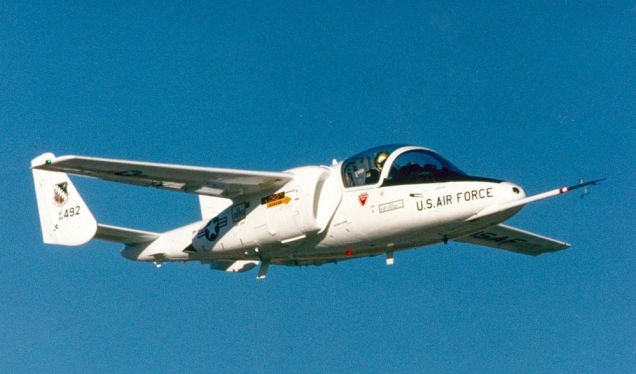
October 15, 1985 – The first flight of the Fairchild T-46 Eaglet, a proposed primary jet trainer developed in response to the US Air Force’s Next Generation Trainer program in 1981 to find a replacement for the Cessna T-37 Tweet . After construction by Burt Rutan of a 62% scale aircraft, the Air Force accepted the Eaglet and placed an order for 650 aircraft. However, despite the success of the T-46, the cost of production had almost doubled, and budget cuts mandated by the Gramm-Rudman-Hollings Balanced Budget Act of 1985 led to the cancellation of the program after only 3 aircraft were built. The cancellation also meant the end of the storied Fairchild Aircraft company. (Fairchild Aircraft photo)
!!! UNKNOWN CONTENT TYPE !!!

October 15, 1952 – The first flight of the Douglas X-3 Stiletto, an experimental aircraft that was designed to investigate sustained flight at supersonic speeds. It was hoped that the Stiletto would maintain speeds of Mach 2, but its Westinghouse J34 afterburning turbojets were so underpowered that it was unable to achieve Mach 1 in level flight, though it did go supersonic in a dive. Despite not reaching its goals, the program was still considered a success, as it provided significant data on fuselage strength necessary for high-speed flight over the course of 51 test flights, and data gleaned from the short, trapezoidal wings was used by Lockheed in their design of the F-104 Starfighter . (NASA photo)
!!! UNKNOWN CONTENT TYPE !!!
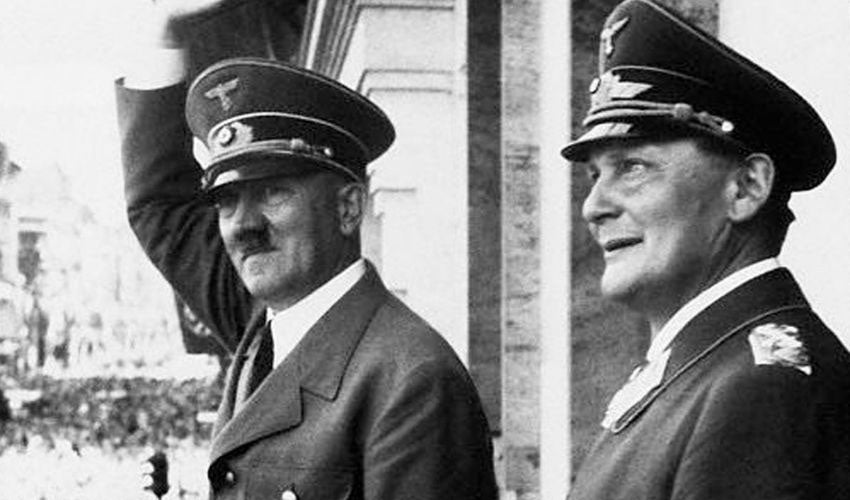
October 15, 1946 – The death of Hermann Göring. Born on January 12, 1893, Göring began his military career as a fighter pilot in WWI, where he became a fighter ace and was awarded the Pour le Mérite , also known as the Blue Max, one of the highest honors of the Kingdom of Prussia. Göring assisted Adolph Hitler in his rise to to power in 1933, forming the feared Geheime Staatspolizei (Gestapo) secret police and becoming the second most powerful man in Germany. He became commander-in-chief of the Luftwaffe in 1935, though the lack of success of the Luftwaffe in 1943 led him to lose some favor with Hitler. Göring eventually withdrew from positions of leadership to focus on looting artwork, and was tried after the war as a war criminal. Convicted and facing death by hanging, Göring committed suicide the night before the prosecution of his sentence. (Photo author unknown)
!!! UNKNOWN CONTENT TYPE !!!
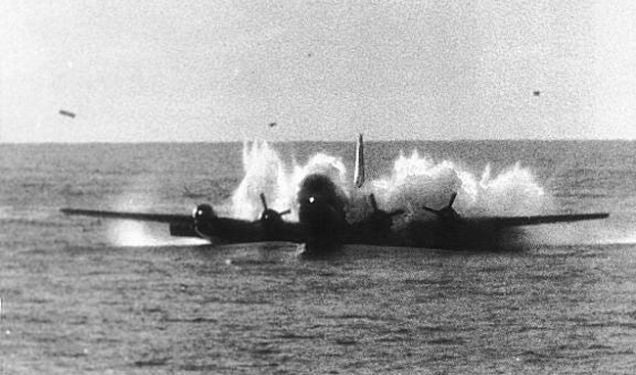
October 16, 1956 – Pan Am Flight 6 ditches in the Pacific Ocean. Pan Am Flight 6 was a scheduled round-the-world flight that departed Philadelphia in a Douglas DC-6 heading eastward and had made a stop in Honolulu before taking off for San Francisco in a Boeing 377 Stratocruiser (N90943). After reaching 21,000 feet, the No. 1 engine entered an overspeed condition, followed by problems with engine No. 4. The captain decided that he would have to ditch in the Pacific Ocean, and rendezvoused with the USCGC Pontchartrain (WHEC-70) that was on station between Hawaii and California. The airliner circled the cutter until dawn to burn off fuel and make the ditching as safe as possible, and landed on a foam path laid out by the cutter. The tail of the aircraft broke off, but all 31 passengers and crew had moved to the front of the plane prior to ditching and were promptly rescued with only minor injuries, though 44 cases of live canaries were lost in the cargo hold. (US Coast Guard photo)
!!! UNKNOWN CONTENT TYPE !!!
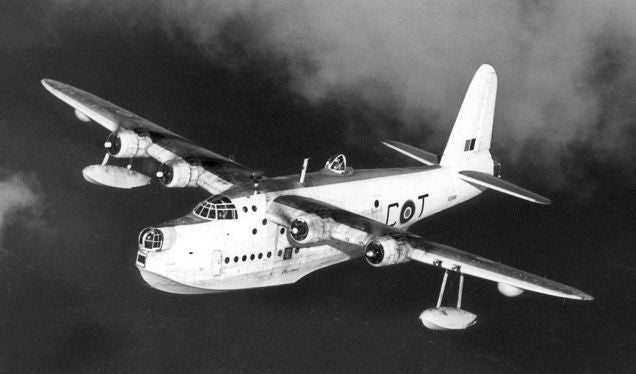
October 16, 1937 – The first flight of the Short Sunderland. One of the great flying boats to come out of the 1930s, the Short Sunderland was partially based on the Short Empire , and the commercial airliner was extensively upgraded for military service and became one of the most powerful and widely used flying boats of WWII. Sunderlands were responsible for tracking and attacking enemy submarines, as well as rescuing victims of submarine attacks. After the war, Sunderlands saw service in the Korean War and the Berlin Airlift and was retired in 1959. Remaining Sunderlands were converted to civilian use as the Short Sandringham , and flew into the 1970s. A total of 777 Sunderlands were produced between 1938 and 1946. (Royal Air Force photo)
!!! UNKNOWN CONTENT TYPE !!!

October 17, 1956 – The birth of Mae Jemison. The first African-American woman to fly in space, Jemison flew as a Mission Specialist on the Space Shuttle Endeavour on STS-47 from September 12-20, 1992, logging just over 190 hours in space. Before becoming an astronaut, Jemison was a practicing physician and a member of the Peace Corps, and cites the role of Lieutenant Uhura on the television series Star Trek as her inspiration for become an astronaut. Following her one mission to space, Jemison retired from NASA in 1993 to start a technology company and made an appearance on Star Trek: The Next Generation in 1993. (NASA photo)
!!! UNKNOWN CONTENT TYPE !!!

October 17, 1952 – The Avro Canada CF-100 Canuck enters service with the Royal Canadian Air Force. The Canuck, known to its pilots as the “Clunk” because of the sound made by the retracting nose wheel, was the only domestically-produced Canadian jet fighter to enter mass production. The CF-100 served as an interceptor for the RCAF throughout the Cold War , serving as part of the North American Aerospace Defense Command (NORAD) and with NATO forces stationed in Europe before eventually being replaced by the McDonnell CF-101 Voodoo . A total of 692 Canucks were produced, and the type was ultimately retired in 1982. (Canadian Department of National Defence photo)
!!! UNKNOWN CONTENT TYPE !!!

October 17, 1922 – The first takeoff from the US Navy’s first aircraft carrier. When Lt. Virgil C. Griffin launched a Vought VE-7 biplane from the deck of the USS Langley (CV-1), it was not not the first aircraft to take off from a ship, nor the first takeoff from a ship equipped with a flight deck. However, the Langley , converted from collier USS Jupiter (AC-3), was the US Navy’s first true aircraft carrier. The flight marked the beginning of US carrier operations and heralded the ascendancy of the aircraft carrier as the new center of naval operations, supplanting the supremacy of the battleship as the nucleus of the modern naval battle group. (Photo author unknown)
!!! UNKNOWN CONTENT TYPE !!!
!!! UNKNOWN CONTENT TYPE !!!
!!! UNKNOWN CONTENT TYPE !!!
!!! UNKNOWN CONTENT TYPE !!!
!!! UNKNOWN CONTENT TYPE !!!
!!! UNKNOWN CONTENT TYPE !!!
!!! UNKNOWN CONTENT TYPE !!!
If you enjoy these Aviation History posts, please let me know in the comments. And if you missed any of the past articles, you can find them all at
Planelopnik History
. You can also find more stories about aviation, aviators and airplane oddities at
Wingspan
.
!!! UNKNOWN CONTENT TYPE !!!
 "lone_liberal" (token-liberal)
"lone_liberal" (token-liberal)
10/17/2017 at 12:52, STARS: 1
I know I’ve said it before but one of my most vivid memories of being in the Navy is seeing multiple C5s with their noses and tails open each with a Sea Dragon inside taking up all of that cargo space. They were headed to the Gulf for mine sweeping duties.
 "cbell04" (cbell04)
"cbell04" (cbell04)
10/17/2017 at 13:06, STARS: 1
Holly balls. I knew a little about those free falls but had never heard the speed they reached while doing it. “reached a speed of 1,357.64 mph in free fall” Great read thanks again.
 "Smallbear wants a modern Syclone, local Maple Leafs spammer" (smallbear94)
"Smallbear wants a modern Syclone, local Maple Leafs spammer" (smallbear94)
10/17/2017 at 13:17, STARS: 1
Chalmers “Slick” Goodlin , demanded $150,000, the equivalent of about $1.6 million today, to make the flight. So the task fell to Chuck Yeager.
I had learned it was because the Air Force wanted it’s own test pilot on board after a certain amount of progress had been made, so that they could keep the results as hushed up as possible. Very interesting...
 "McMike" (mcmike)
"McMike" (mcmike)
10/17/2017 at 13:19, STARS: 0
Never mind, I thought that was the Cessna Tweet trainer.
 "ttyymmnn" (ttyymmnn)
"ttyymmnn" (ttyymmnn)
10/17/2017 at 13:20, STARS: 1
Serendipity for the AF?
 "ttyymmnn" (ttyymmnn)
"ttyymmnn" (ttyymmnn)
10/17/2017 at 13:24, STARS: 0
Which makes Joseph Kittinger’s jump even that much more impressive, since the did it with 1950s technology. Thanks, and thanks for reading!
 "ttyymmnn" (ttyymmnn)
"ttyymmnn" (ttyymmnn)
10/17/2017 at 13:26, STARS: 1
I lived in Norfolk for many years, and saw those lumbering helos overhead all the time. That was also back in the days when F-14s were still flying out of NAS Oceana. No lack of inspiration for a budding airplane nut.
 "Smallbear wants a modern Syclone, local Maple Leafs spammer" (smallbear94)
"Smallbear wants a modern Syclone, local Maple Leafs spammer" (smallbear94)
10/17/2017 at 13:37, STARS: 1
I guess so. Easy excuse to go the way they wanted.
 "lone_liberal" (token-liberal)
"lone_liberal" (token-liberal)
10/17/2017 at 13:46, STARS: 1
I was on Diego Garcia when we were escorting tankers during the Iran-Iraq war which was the reason the Sea Dragons were on their way. The sound of F14s and F18s coming and going in to Diego’s air strip when a carrier was coming in was certainly different than our normal P3s and S3s!
 "ttyymmnn" (ttyymmnn)
"ttyymmnn" (ttyymmnn)
10/17/2017 at 13:50, STARS: 0
That’s the sound of Freedom™!

10/17/2017 at 14:29, STARS: 2
OM NOM NOM
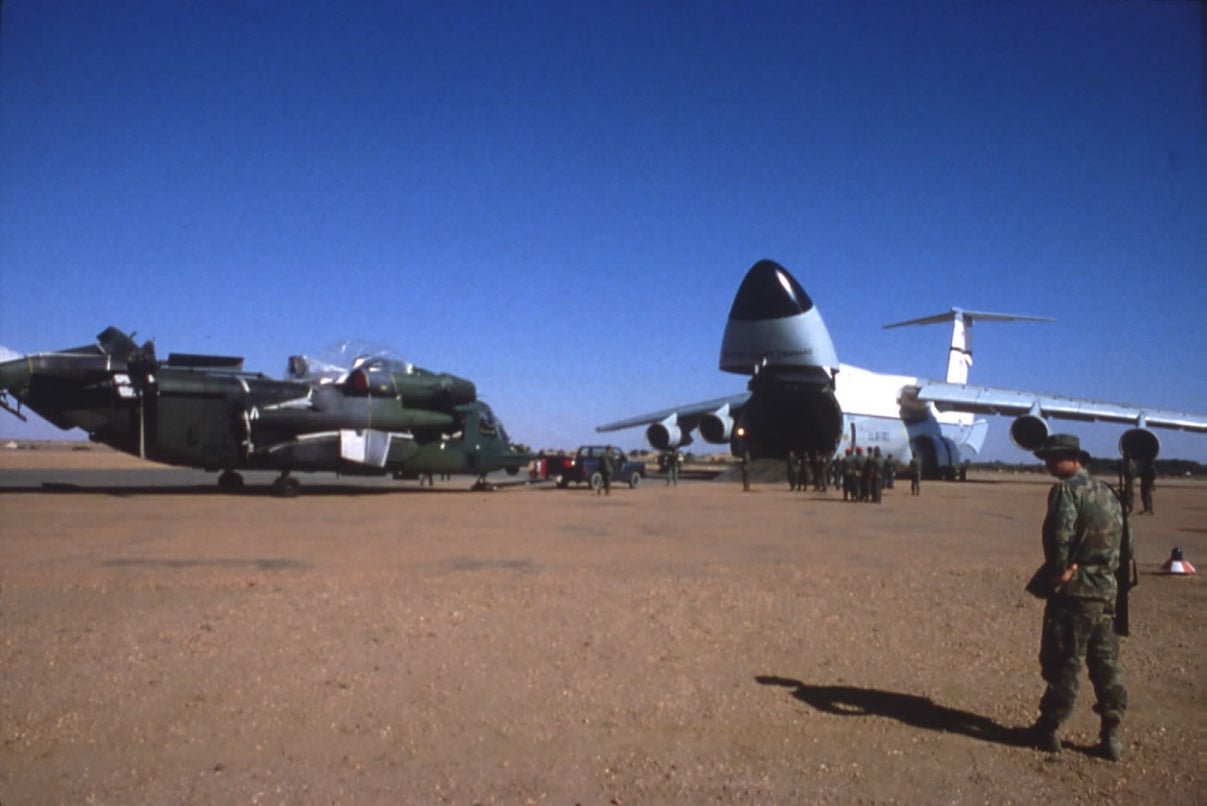
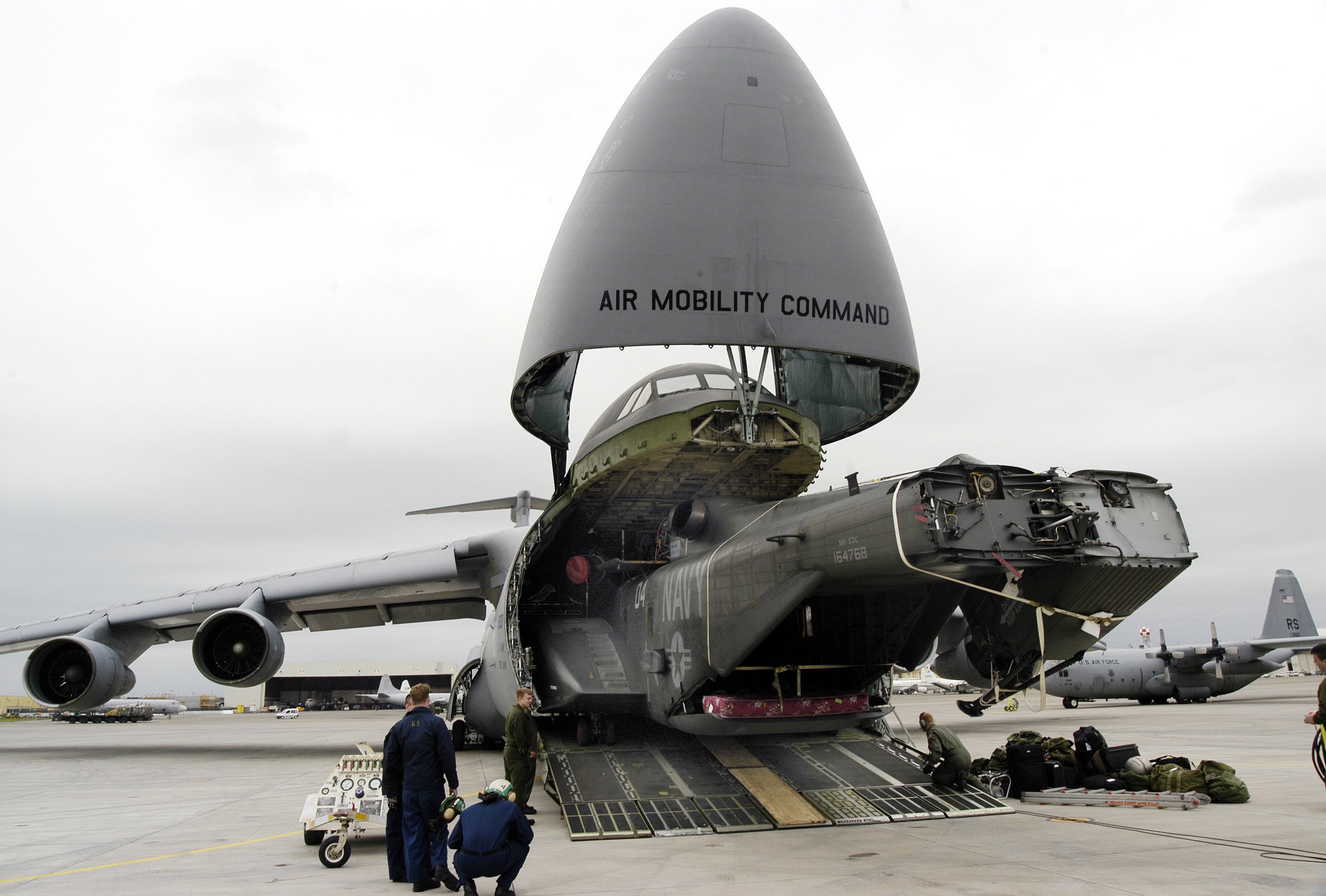
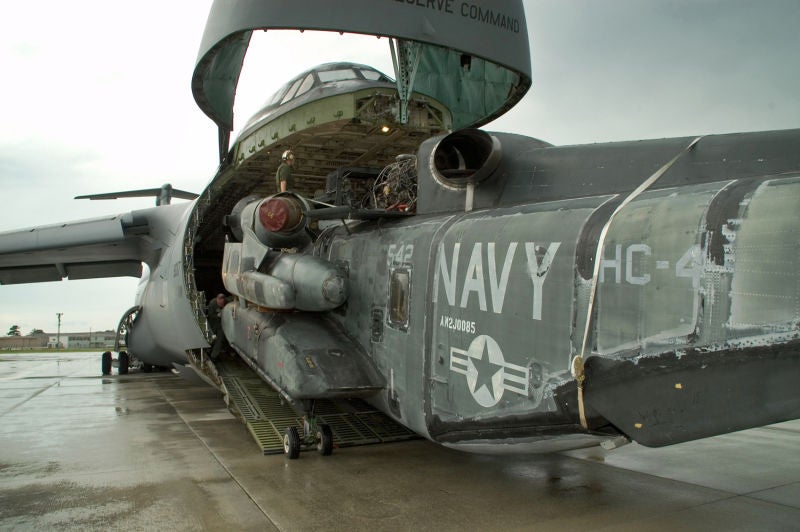
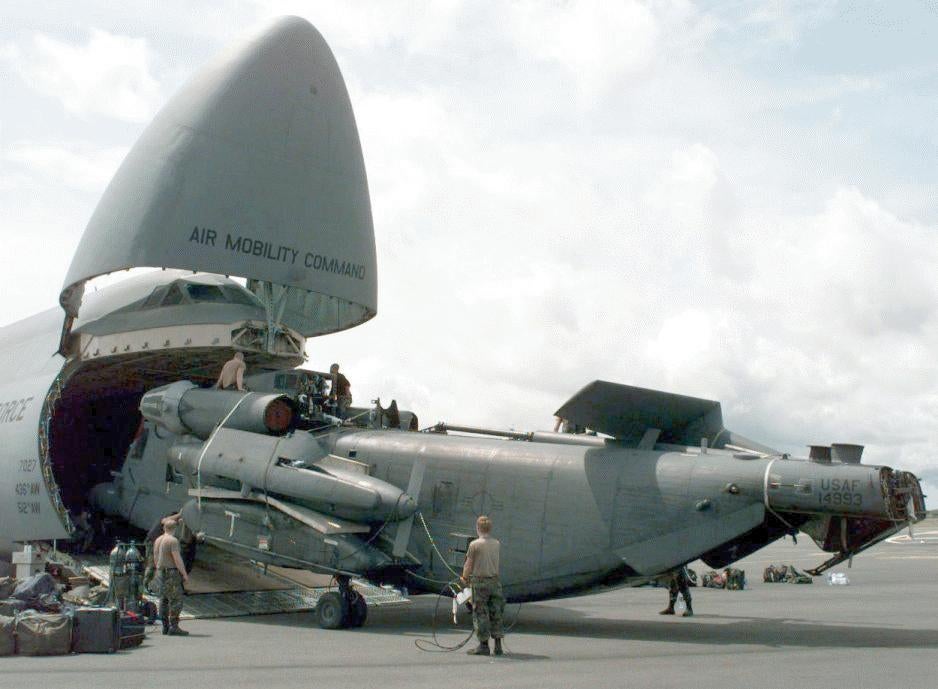


10/17/2017 at 14:40, STARS: 1
Amazingly all three T-46 prototypes are intact and on display (or will be in due time). One’s awaiting restoration (also, ‘dat X-32 and YF-23!) at the USAFM in Dayton , another is on display at AMARG / Pima A&S and the third is at the AFFTM at Edwards AFB.
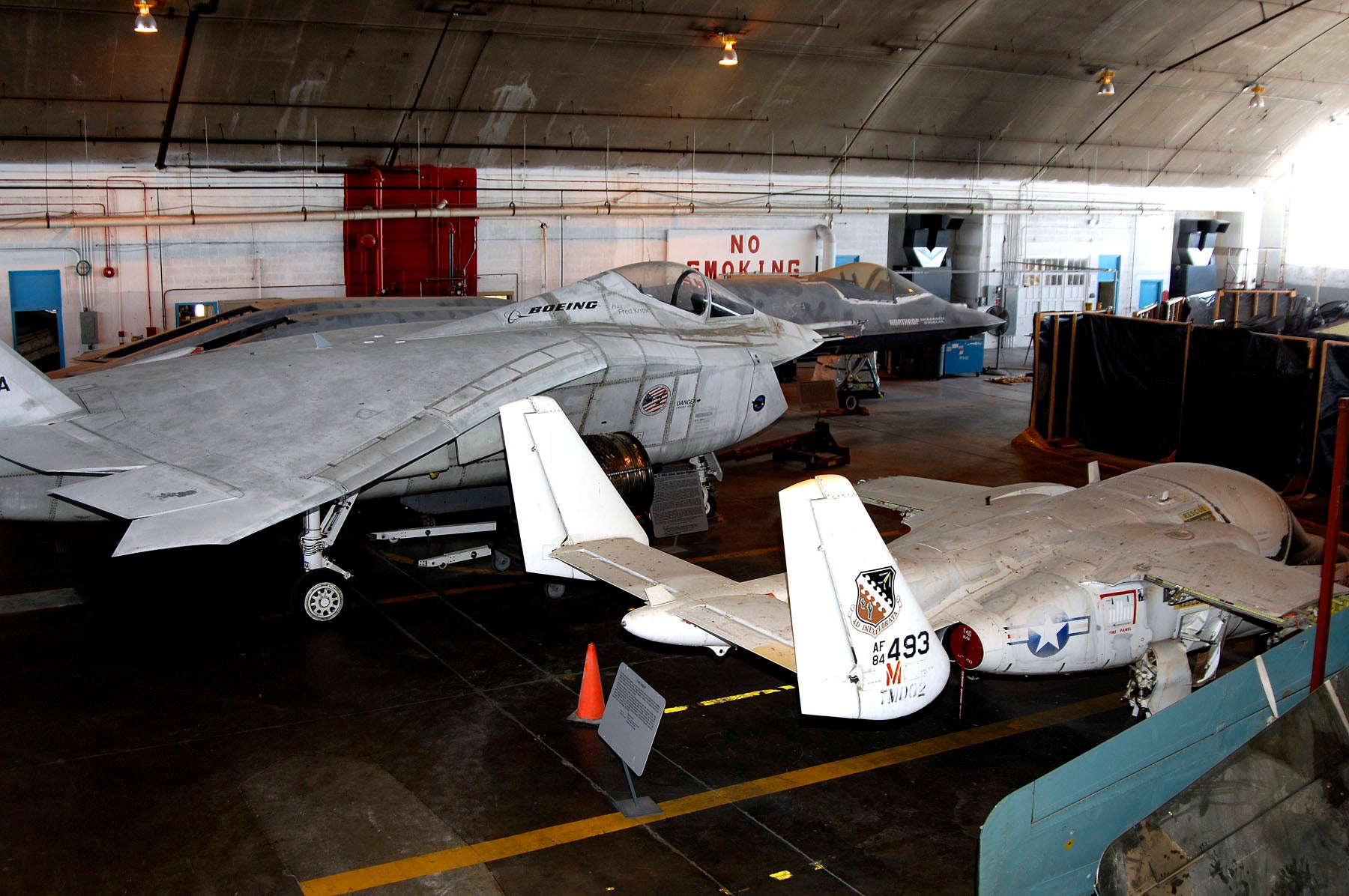
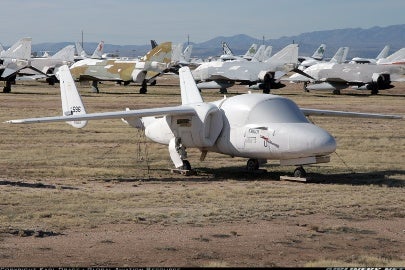
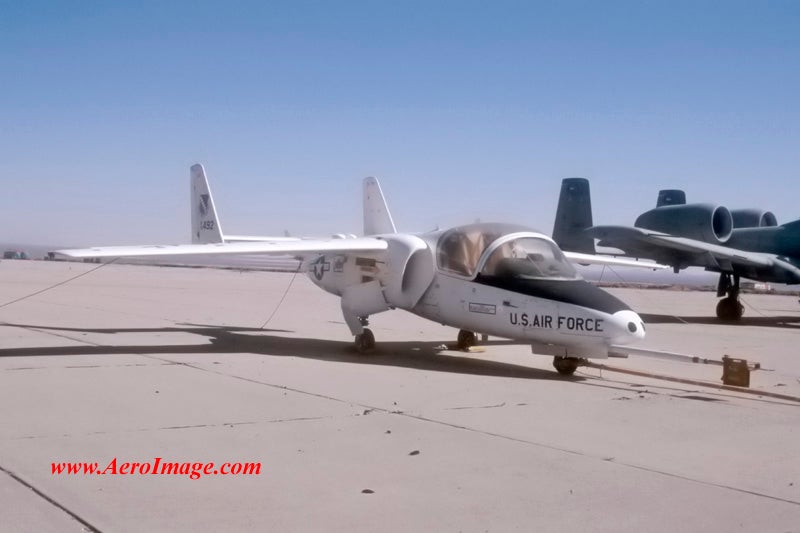
 "ttyymmnn" (ttyymmnn)
"ttyymmnn" (ttyymmnn)
10/17/2017 at 15:01, STARS: 1
Dat JSF doe. I’d like to see that up close.

10/17/2017 at 15:06, STARS: 1
The X-32B is on display at the Pax River NAM , if you’re ever in Maryland
 "ttyymmnn" (ttyymmnn)
"ttyymmnn" (ttyymmnn)
10/17/2017 at 15:28, STARS: 0
Good to know, but I won’t be in MD for quite some time.
 "Fl1ngstam" (Fl1ngstam)
"Fl1ngstam" (Fl1ngstam)
10/18/2017 at 04:29, STARS: 0
Another great article. I’m still upset about the Miles M.52. The promised exchange of technical data with the Americans didn’t happen, so precious Intellectual property only flowed one way. Then the British Government short-sightedly cancelled the project. Without those two factors, it’s quite possible that the British would have broken the sound barrier first, and post-war aircraft development would have been quite different. Having said that, there wasn’t exactly an abundance of money in the UK at the time...
 "You can tell a Finn but you can't tell him much" (youcantellafinn)
"You can tell a Finn but you can't tell him much" (youcantellafinn)
10/18/2017 at 07:32, STARS: 0
This is the first time I’ve noticed you named your recent posts section. Nice, I like the Connecting Flights name.
Looking at the CH-53E I wondered where the third turbine was so went digging on Wikipedia. Besides the asymmetry of just slapping the third turbine on there, I’ve got a problem with the squadron name. That’s like naming an F-18 squadron the Fighting Falcons. It’s just not right.
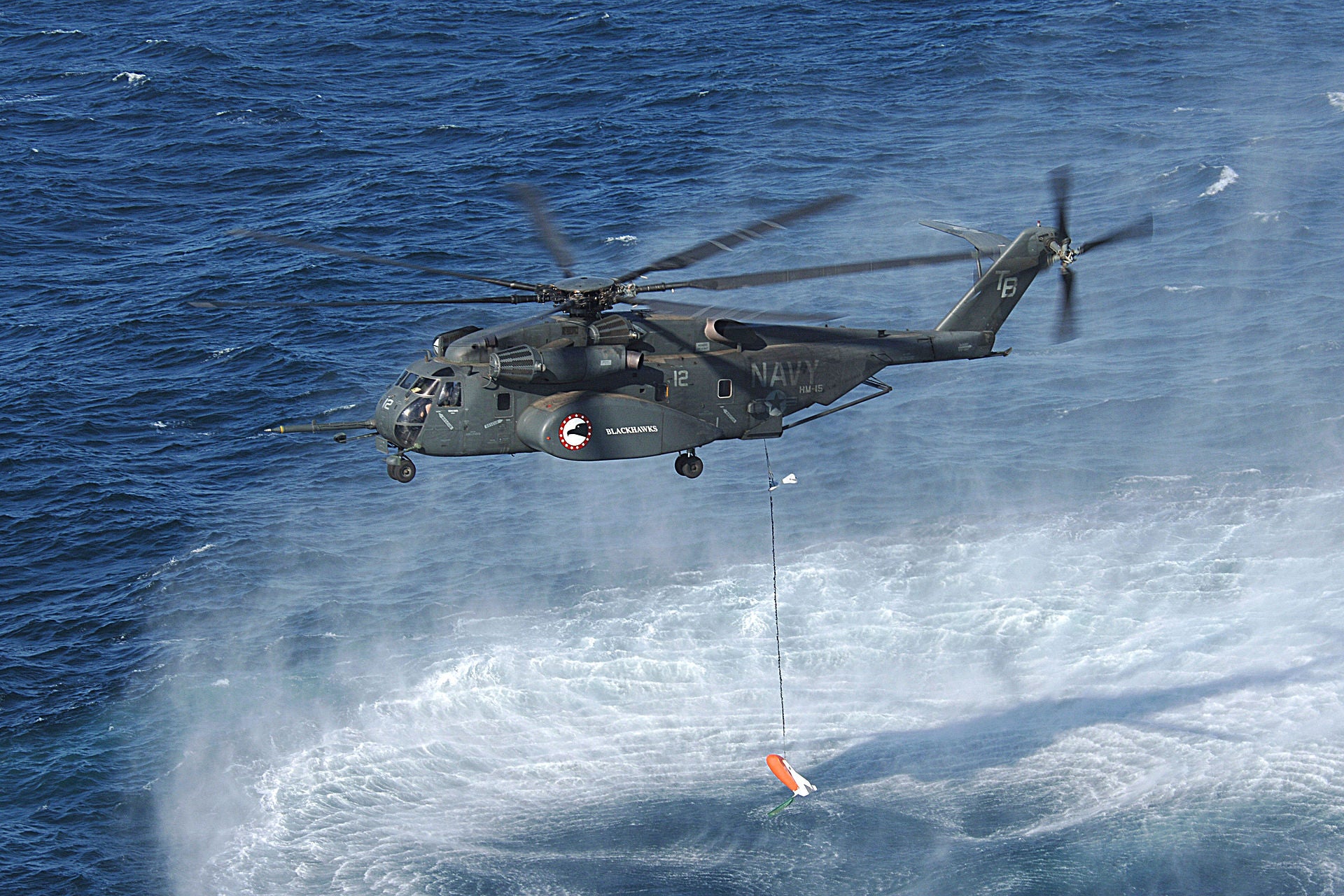
 "X37.9XXS" (x379xxs)
"X37.9XXS" (x379xxs)
10/18/2017 at 08:25, STARS: 1
Talk about a legendary week
A few comments:
I was in Schweinfurt in 2012 and they are still making ball bearings

In Re: HH-53 - “Somebody here call a cab?” (Eternal thanks to the crew of Jolly Green 48 )
The Sunderland may be the only flying boat to have shot down three fighters.
https://en.wikipedia.org/wiki/Short_Sunderland#Operational_history
 "ttyymmnn" (ttyymmnn)
"ttyymmnn" (ttyymmnn)
10/18/2017 at 09:03, STARS: 0
Thanks for noticing that. I’m pretty happy with that bit of inspiration, and it’s more fitting since I’m now linking other articles besides just TDIAH posts.
It’s not like Blackhawks is a historical name, either. That squadron was only created in 1987.
 "ttyymmnn" (ttyymmnn)
"ttyymmnn" (ttyymmnn)
10/18/2017 at 09:11, STARS: 1
Thanks. The whole postwar/Cold War history of British aviation is a sad tale of what could have been. Lots of great ideas that were cut short either for budgets or politics.